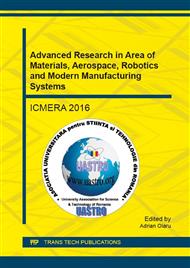[1]
Inamura, T., Senda, T. and Sata, T., Computer control of chattering in turning operation, Ann. CIRP, 1977, 25, 1.
Google Scholar
[2]
Takemura, T., Kitamura, T. and Hoshi, T., Active suppression of chatter by programmed variation of spindle speed. Ann. CIRP, 1974, 23, 1.
Google Scholar
[3]
Jemielniak, K and Widota, A. Suppression of self-excited vibration by spindle speed variation method,. Int.J. Mach. Tool Des, Res., 1984, 24 (3), 207-214.
DOI: 10.1016/0020-7357(84)90005-2
Google Scholar
[4]
Montgomery, D.C., Introduction to Statistical Quality Control, 4th edition, New York, NY: John Wiley & Sons, (2001).
Google Scholar
[5]
Lowry, C.A. and Montgomery, D.C. A review of multivariate control charts, IIE Transactions, Vol. 27, p.800–810, (1995).
DOI: 10.1080/07408179508936797
Google Scholar
[6]
Woodall, W.H. and Montgomery, D.C. Research issues and ideas in statistical process control, Journal of Quality Technology, Vol. 31, p.376–386, (1999).
DOI: 10.1080/00224065.1999.11979944
Google Scholar
[7]
Stoumbos, Z.G., Reynolds, M.R., Ryan, T.P. and Woodall, W.H., The state of statistical process control as we proceed into the 21st century, Journal of the American Statistical Association, Vol. 95, p.992–998, (2000).
DOI: 10.1080/01621459.2000.10474292
Google Scholar
[8]
JESCHKE, K., Metode si instrumente ale asigurarii calitatii, ICPIAF, Cluj-Napoca, (1997).
Google Scholar
[9]
Breaz, R.E., Bologa, O., Oleksik. V., Racz, G., Computer Simulation for the Study of CNC Feed Drives Dynamic Behavior and Accuracy, The IEEE Region 8 EUROCON 2007, International Conference on Computer as a tool, pp.2094-2098, ISBN 1-4244-0813-X , IEEE Catalog No. 07EX1617C, Library of Congress: 2006937182, Warsaw University of Technology, Warsaw, Poland, September 9-12, (2007).
DOI: 10.1109/eurcon.2007.4400575
Google Scholar
[10]
Somkiat T., In-Process Monitoring and Prediction of Surface Roughness in CNC Turning Process,. Advance Materials Research 199-200. pp.1958-1966, (2011).
DOI: 10.4028/www.scientific.net/amr.199-200.1958
Google Scholar
[11]
Gelmereanu, I. C, Campean, E. M., Morar, L. Considerations regarding the milling operations efficiencies by increasing productivity, Technical University of Cluj-Napoca, Revista de Management si Inginerie Economica, Volume 13, Number 1, pp.71-78, (2014).
Google Scholar
[12]
Ferent-Pipas, S.; Padurean, B.; Ciupan, C., Mathematical Model for the Calculation of Linear Speed for a Water Jet Cutting Machine, Applied Mechanics and Materials, 332, Trans Tech Publ, pp.411-416, (2013).
DOI: 10.4028/www.scientific.net/amm.332.411
Google Scholar


